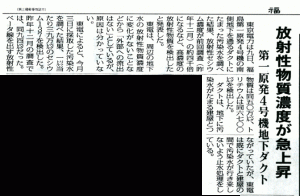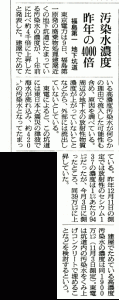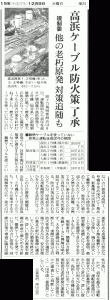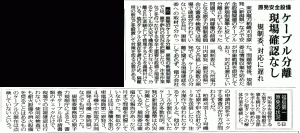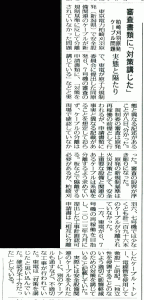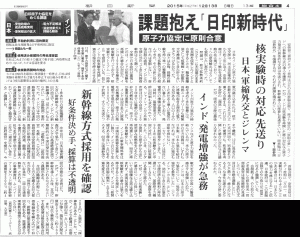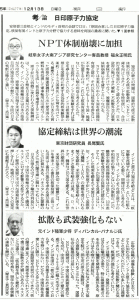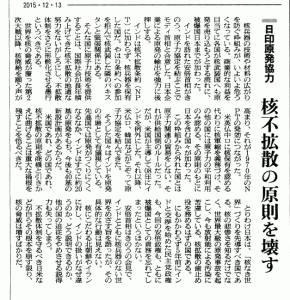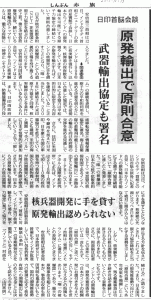Original Japanese written by staffer
The English below translated from the original Japanese by Heeday
The English translation edited by Rev. Dr. Henry French, ELCA
(Based on articles from the December 10th, 2015 edition of the Fukushima Minpo newspaper and the December 11th edition of the Asahi Shimbun newspaper)
▼Click each image and read the caption.
TEPCO has discovered that the density of contaminated water stored within an underground tunnel known as a “duct” at its Fukushima Daiichi Nuclear Power Plant (NPP) has risen by some 4,000 to 4,100 times since a year before. The NPP houses some facilities called “waste processing buildings” around which there are underground tunnels known as “ducts.” They still store some 400 to 500 tons of contaminated water which originated both from sea water from the tsunami of March 2011, and from other sources. The power company collected some samples of this contaminated water and inspected them on December 3rd, 2015 They detected 482,000 becquerel of radioactive cesium per liter (0.254 gallon) and some 500,000 becquerel of radioactive substances that emit the b ray. Compared to a previous inspection in December 2014, the contaminant concentration has, on the average, increased by some 4,000 to 4,100 times.
The “waste processing buildings” next to the duct in question temporarily store high-density contaminated water used to cool the melting down nuclear fuels.
TEPCO is trying to identify the cause of this drastic rise in the concentration of radioactive substances. One possibility is that the highly contaminated water in the waste processing building has leaked and run into the duct. Since the underground water around the duct shows no sign of a rise in the concentration of radioactive substances, the contaminated water has not leaked out of the duct, according to the power company.
Since there is no way that the density of radioactive substances “naturally” rise, one has every reason to suspect that there are some cracks somewhere in a joint of the processing building or a water stop through which high-density contaminated water runs. The power company has to identify the cause and resolve it as soon as it can. Otherwise, the water’s contamination density can keep skyrocketing.
Also, with almost five years passed since the March 2011 meltdown, the NPP’s waste storage buildings and tanks of contaminated water should deteriorate further with aging. At Fukushima Daiichi, the support columns of exhaust towers show rust and deformities, breaking at multiple places. Experts say they are in danger. The radioactive contamination around such a tower is as high as 25,000mSv/hr, which will kill you in only a dozen minutes or so. If any of the towers collapse now, more radioactive substances will be released. Urgent countermeasures are a must, according to the February 20, 2015 edition of the Akahata newspaper.
Meanwhile, at Chernobyl, “sealed up” Unit 4 is now posing a serious threat, 29 years after the disaster. The sarcophagus—the cement and steel structure that encases the destroyed reactor at the power station in Chernobyl—is aging and part of the walls and the roof are already beginning to collapse. This can lead to re-leakage of radioactive substances. Thus, they are building a structure that wraps the whole sarcophagus. The structure can last some 100 years, according to sources. Radioactive contamination, meanwhile, can last at least ten times that, judging from the half lives of many radioactive substances. This means they will need to re-build such a structure at least ten times.
The decommissioning of Fukushima Daiichi has been haunted by one problem after another, and such problems can grow even tougher in the years ahead. Is the decommissioning possible, at all? Currently no one knows the correct answer to this question.
NPPs carry such serious risks. I believe that more people need to know the truth about nuclear power. Once a person knows the truth, he/she can form their own ideas about nuclear power and then put them into practice. To make that happen, the Project on Nuclear Power and Radiation intends to spread what is happening here in Fukushima as factually as possible and in the easiest possible way to understand.

